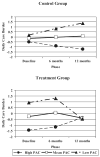Positive aspects of caregiving as a moderator of treatment outcome over 12 months
- PMID: 17563191
- PMCID: PMC2579267
- DOI: 10.1037/0882-7974.22.2.361
Positive aspects of caregiving as a moderator of treatment outcome over 12 months
Abstract
The authors examined the influence of positive aspects of caregiving (PAC) as a moderator of treatment outcome across 12 months in 1 of the original sites of the Resources for Enhancing Alzheimer's Caregiver Health I project. They used multilevel random coefficients regression analysis to predict time-varying PAC, depression, behavioral bother, and daily care burden in Alzheimer's caregivers (N = 243; mean age = 60.89, SD = 14.19). They found that time-varying PAC was predicted by time-varying daily care burden. They also found significant effects of time-varying PAC for depression, behavioral bother, and daily care burden. Notably, a PAC x Phase x Treatment effect was found for daily care burden, such that individuals who endorsed less PAC benefited most from the intervention across 12 months. The tendency to positively appraise the caregiving experience (i.e., PAC) in response to chronic stressors such as Alzheimer's caregiving may affect individuals' responsiveness to, and benefit from, interventions, whereas only daily care burden affected the tendency to find enjoyment in caregiving across 12 months. Future intervention research should assess individual PAC in order to better tailor interventions to caregiving needs.
((c) 2007 APA, all rights reserved).
Figures



References
-
- Adamson JA, Price GM, Breeze E, Bulpitt CJ, Fletcher AE. Are older people dying of depression? Findings from the Medical Research Council trial of the assessment and management of older people in the community. Journal of the American Geriatrics Society. 2005;53:1128–1132. - PubMed
-
- Barrera M, Jr, Sandler IN, Ramsay TB. Preliminary development of a scale of social support: Studies on college students. American Journal of Community Psychology. 1981;9:435–447.

